When you dip homemade cheese in beeswax, you're creating a natural protective barrier that controls moisture and shields against external contaminants. The coating helps prevent mold growth while allowing beneficial microorganisms to thrive during aging. You'll find that beeswax preserves the cheese's authentic flavors and enhances its pliability when mixed with vegetable shortening or coconut oil. It's easy to apply through brushing or dipping, and you can maintain quality by applying multiple thin coats instead of one thick layer. There's much more to discover about this traditional preservation method that artisanal cheesemakers have trusted for generations.
Natural Mold Prevention Methods
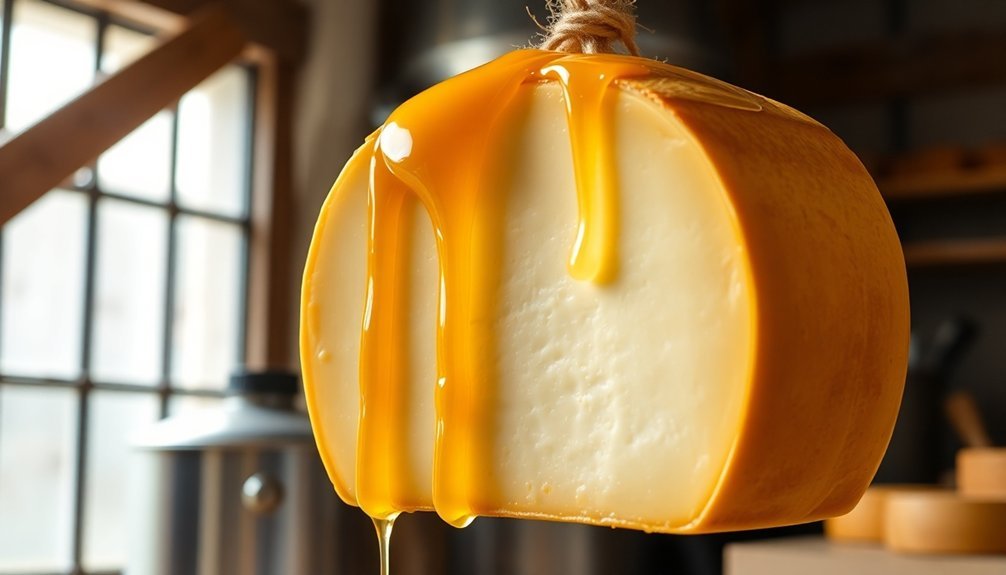
Mold prevention strategies play a crucial role in cheese aging, and natural methods can effectively protect your homemade cheese without compromising quality.
Beeswax coating serves as your first line of defense, creating a protective barrier that prevents unwanted mold growth while allowing your cheese to age properly. Regular weekly inspections are essential to catch any early signs of mold development.
You'll need to maintain specific environmental conditions to support proper aging. Keep your aging space between 35-45°F (2-7°C) and maintain relative humidity levels of 85-95%.
Don't forget to guarantee proper air circulation, as stagnant air can lead to moisture buildup and encourage mold growth.
You can also use salt brining as a natural mold deterrent. When you soak your cheese in a saltwater solution, you're creating an inhospitable environment for unwanted mold while enhancing the cheese's flavor profile.
If you're making specific varieties like blue cheese or brie, you'll want to introduce beneficial cultures like Penicillium Roqueforti or Penicillium Camemberti, respectively.
These cultures not only contribute to the desired flavor and texture but also help prevent harmful mold growth by occupying the space where unwanted molds might develop.
Moisture Balance in Cheese Making
Your homemade cheese's moisture balance directly affects its texture, flavor, and aging process, making proper humidity control crucial for success.
You'll need to maintain specific humidity levels, typically between 75-95%, using tools like hygrometers and humidistats to protect your cheese's internal structure and prevent excessive moisture loss.
While beeswax coating offers an effective barrier against unwanted moisture exchange, you should still monitor the ambient conditions to guarantee your cheese develops the desired characteristics during aging. Regular monitoring helps prevent case hardening defects from developing on your cheese's surface.
Preventing Excessive Water Loss
Maintaining proper moisture levels throughout the cheese-making process stands out as one of the most essential factors for success. You'll need to carefully manage several key variables to prevent your cheese from losing too much water during production and aging.
Start by adjusting your curd cutting technique – larger curds will retain more moisture than smaller ones. When you're cooking the curds, keep temperatures lower and watch your timing closely. The ideal temperature of 72 degrees Fahrenheit during draining helps achieve optimal texture.
During the pressing stage, you can preserve moisture by reducing both the pressure and duration of pressing.
Your aging process requires careful attention too. You'll want to monitor the duration, as extended aging periods can lead to excessive drying.
When it comes to wrapping, choose breathable materials that maintain the right moisture balance for your specific cheese type.
Beeswax coating plays a vital role in moisture retention. You'll need to apply it evenly across the entire surface, and you can improve its pliability by mixing it with vegetable shortening, lard, or coconut oil.
Don't forget to regularly inspect the wax coating for any cracks that might allow unwanted moisture loss. These preventive measures will help guarantee your cheese maintains its ideal moisture content throughout the aging process.
Optimal Humidity Control Techniques
Beyond preventing water loss during production, proper humidity control throughout the aging process will make or break your cheese's final quality.
You'll need to maintain specific humidity ranges based on your cheese type: 90-95% for soft cheeses, 85-90% for semi-hard varieties, and 80-85% for hard cheeses.
To achieve these precise levels, you've got several effective options. Install a humidity controller with its sensor at cheese level, and connect it to a humidifier or mister for automated control.
You can also use traditional methods like placing water trays in your aging space or hanging damp cloths to boost moisture levels. For more precise control, consider using saturated salt solutions – sodium chloride maintains about 75% humidity, while potassium chloride reaches around 85%.
Don't forget about air circulation – it's vital for preventing moisture from condensing on your cheese's surface.
Place your cheese on mats or wood boards to allow air flow underneath, and regularly turn and wipe the cheese to prevent mold growth.
Monitor humidity levels consistently with a hygrometer, and adjust your ventilation and temperature settings as needed to maintain ideal conditions.
Internal Structure Protection
The internal structure of your cheese relies heavily on proper moisture balance throughout the aging process. When you coat your cheese in beeswax, you're creating a protective barrier that maintains ideal moisture levels while allowing the cheese to age naturally. This balance is vital for developing the proper texture and ensuring that your cheese doesn't dry out or retain too much moisture.
You'll find that beeswax works as a semi-permeable membrane, helping to regulate the internal moisture content of your cheese. It retains essential whey and fat components while preventing excessive moisture loss that could compromise the cheese's structure. The wax coating also supports even aging by maintaining consistent moisture levels throughout the cheese mass.
To protect your cheese's internal structure effectively, you'll need to apply the beeswax carefully after pressing and drying. You can mix the beeswax with vegetable shortening to achieve better pliability and coverage. This combination allows you to control moisture levels by adjusting the thickness of your wax application.
Remember to monitor your cheese regularly, as proper internal structure development depends on maintaining the wax coating's integrity throughout the aging period.
Enhancing Traditional Cheese Flavors
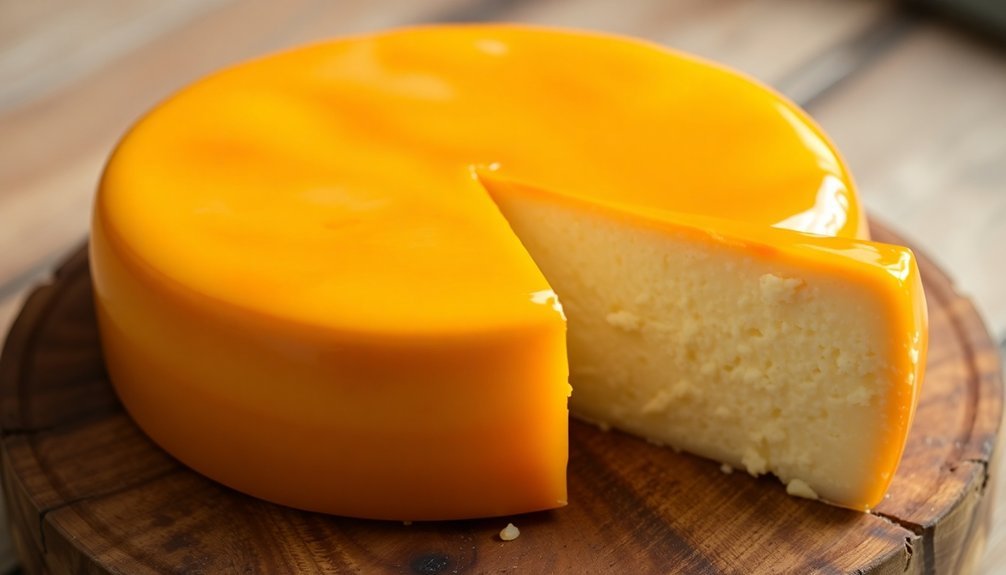
When you dip homemade cheese in beeswax, you're not just preserving it – you're releasing its full flavor potential. The beeswax coating creates a protective barrier that maintains your cheese's inherent flavors while preventing unwanted external influences.
You'll find that this traditional method helps retain moisture and volatile compounds, guaranteeing your cheese develops a complex, well-balanced taste profile over time.
By maintaining consistent moisture levels and providing a stable aging environment, beeswax coating supports the natural enzymatic processes that make your cheese truly exceptional. The coating also helps beneficial microorganisms thrive while preventing unwanted mold growth that could compromise your cheese's flavor.
- The natural honey-like aroma of beeswax complements your cheese's developing flavors without overwhelming them
- Adding fats like coconut oil to your beeswax mixture improves sealing and guarantees even flavor development
- Your cheese's volatile compounds stay locked in, creating a more intense and nuanced flavor profile
- The protective seal prevents external odors from contaminating your aging cheese
- You'll achieve more uniform aging throughout the cheese, resulting in consistently balanced flavors
Environmental Protection During Aging
Protecting your homemade cheese during aging requires careful attention to environmental conditions, and beeswax coating serves as a vital defense system. When you apply beeswax to your cheese, you're creating a natural barrier that controls moisture balance while allowing necessary breathability, preventing both excessive drying and unwanted moisture accumulation.
The beeswax coating shields your cheese from external contaminants, strong odors, and potential spoilage agents. You'll find that this protective layer helps maintain your cheese's unique flavor profile and aroma throughout the aging process.
Proper storage conditions become easier to maintain when your cheese is waxed, as you'll want to keep it at 52-56°F with 85% humidity.
Regular maintenance of your waxed cheese is important. You'll need to turn it periodically to verify even aging and check for any signs of mold development beneath the wax.
The breathable nature of beeswax helps minimize trapped moisture that could foster mold growth, but you'll still want to inspect your cheese regularly. By maintaining these ideal conditions, you're creating an excellent environment for your cheese to develop its desired texture and flavor characteristics.
Monitoring Through Wax Layers

Successful cheese monitoring through beeswax layers requires careful attention to detail and regular inspection routines. You'll need to regularly check your waxed cheese for any signs of deterioration, mold growth, or wax damage.
Turn your cheese weekly while examining the wax surface for cracks or thin spots that could compromise your cheese's protection.
Before applying wax, make certain you've properly prepared your cheese by removing any surface moisture and sanitizing with a vinegar wash. When dipping, maintain your wax temperature between 200-210°F (93-99°C) and apply thin, even layers for ideal coverage.
Here are essential monitoring steps you'll need to follow:
- Check weekly for wax cracks or separations from the cheese surface
- Look for any discoloration that might indicate mold growth beneath the wax
- Monitor the storage environment's temperature and humidity levels
- Inspect label dates to track aging progress
- Examine cheese through the wax for any unusual swelling or gas formation
Store your waxed cheese in a cool, dry place away from direct sunlight, and keep different varieties separated to prevent flavor transfer.
Regular monitoring helps guarantee your cheese ages properly while maintaining its quality throughout the process.
Sustainable Waxing Practices
You'll find multiple ways to reuse your beeswax through proper filtering and storage, which can greatly reduce waste in your cheese-making process.
By implementing zero-waste techniques, such as collecting and melting down used wax fragments, you're actively contributing to natural resource conservation.
When you maintain clean waxing practices and store filtered wax properly, you can reuse it multiple times for future batches of cheese, making the entire process more sustainable and cost-effective.
Recycling Used Wax Methods
Recycling beeswax extends its lifecycle while promoting sustainable practices in cheese waxing. You'll need to start by collecting pure beeswax scraps, guaranteeing they're free from contaminants like pollen or dyes. For effective recycling, gather at least 8oz of wax to make the process worthwhile.
To properly recycle your used cheese wax, you'll need to follow a thorough cleaning and purification process. Start with a sodium bicarbonate bath, then use the double-sacking method with burlap bags to remove impurities. Heat the wax in a honey-water mixture at 190°F for 24 hours to eliminate volatile residues.
- Use a double boiler to melt the cleaned wax, preventing direct heat contact.
- Filter the melted wax through buttermuslin or fine cheesecloth.
- Cool the wax in thin trays to guarantee proper solidification.
- Expose the wax to UV light to photo-degrade any remaining surface residues.
- Test the wax's purity before using it on your cheese.
Once purified, you can reuse the wax for cheese coating or repurpose it into other products. This recycling process not only saves money but also guarantees you're maintaining sustainable practices in your cheese-making journey.
Natural Resource Conservation
Building on these recycling practices, sustainable waxing with beeswax represents a cornerstone of natural resource conservation in cheese-making. You'll find that beeswax's renewable nature makes it an ideal choice for environmentally conscious cheese producers, especially when you're looking to reduce your reliance on petroleum-based alternatives.
| Resource Aspect | Beeswax Benefits | Environmental Impact |
|---|---|---|
| Source Material | Natural bee product | Supports pollination |
| Production | Minimal processing | Low carbon footprint |
| Longevity | Multiple reuse cycles | Reduces waste |
| Application | Small quantities needed | Resource efficient |
| Disposal | Biodegradable | Eco-friendly |
When you use beeswax for cheese coating, you're supporting local beekeepers and maintaining essential pollinator populations. The wax's durability means you'll need less material over time, and its effectiveness in small quantities further reduces resource consumption. You can maximize conservation by properly maintaining your beeswax, ensuring it remains usable for multiple cycles. This approach not only preserves traditional cheese-making methods but also aligns with modern sustainability goals, helping you minimize your environmental impact while producing high-quality cheese products.
Zero-Waste Waxing Techniques
A well-executed zero-waste waxing technique starts with selecting sustainable materials and methods for cheese preservation.
You'll want to embrace reusable cloth strips made from old cotton sheets instead of disposable plastic alternatives, as they're both effective and environmentally friendly.
When it comes to the wax itself, consider using natural alternatives like sugar wax or honey-based recipes that minimize environmental impact while providing excellent preservation properties.
These sustainable waxing methods offer significant benefits for cheese preservation while reducing waste:
- Cloth strips can be washed and reused multiple times, eliminating single-use plastic waste
- Natural waxes are biodegradable and dissolve easily in hot water
- Homemade recipes use common household ingredients, reducing packaging waste
- Natural ingredients cause less environmental harm compared to commercial products
- DIY waxing methods are cost-effective and sustainable long-term
Benefits of Beeswax Application
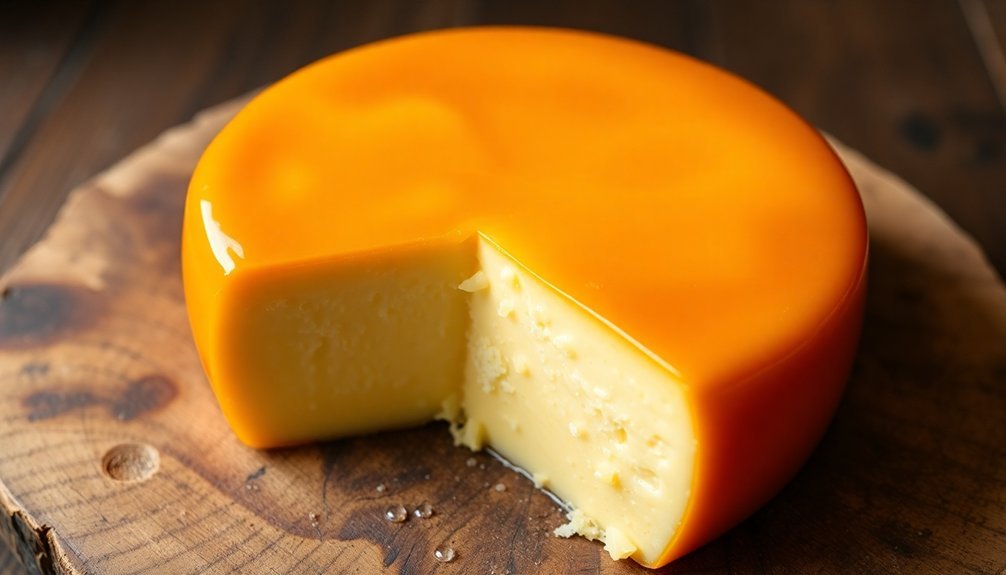
Coating cheese in beeswax offers multiple protective and flavor-enhancing benefits that make it an excellent choice for aging and preserving homemade cheese. You'll find that beeswax creates an effective barrier against mold growth while maintaining the perfect moisture balance within your cheese.
When you apply beeswax correctly, it'll protect your cheese from unwanted mold spores while allowing it to breathe just enough for proper aging. The wax's natural properties contribute to developing complex flavors and aromas, often adding subtle honey notes to your aged cheese.
| Benefit | How It Works | What You'll Notice |
|---|---|---|
| Mold Prevention | Creates protective barrier | Clean, mold-free surface |
| Moisture Control | Seals in natural humidity | Consistent texture |
| Flavor Enhancement | Allows controlled aging | Rich, complex taste |
| Easy Application | Brush or dip method | Even coverage |
| Reusability | Peel and strain | Cost-effective |
You can enhance your waxing results by mixing beeswax with vegetable shortening or coconut oil for better pliability. Apply multiple thin coats rather than one thick layer to prevent cracking, and you'll create the ideal environment for your cheese to age perfectly.
Traditional Preservation Techniques
Traditional cheese preservation spans centuries of ingenious techniques that extend far beyond simple waxing.
You'll find that wood ash preservation, one of the most fascinating methods, involves carefully surrounding cheese pieces with sifted ash in a stoneware pot. When you store this pot in a cool cellar, you're creating ideal conditions that can keep your cheese fresh for several months.
For best results when using traditional preservation methods, you'll want to select thicker pieces of cheese, as the ash will create a new protective rind during storage.
While these time-tested techniques might seem more labor-intensive than modern alternatives like vacuum sealing, they've proven their worth through generations of cheesemaking.
Here are key traditional preservation methods you can explore:
- Wood ash storage in stoneware pots for extended shelf life
- Natural material storage using wood, clay, or limestone for proper humidity
- Cellar aging with controlled temperature and moisture
- Slate or marble platforms for cooling and serving
- Beeswax coating with coconut oil for enhanced protection
Each of these methods offers unique benefits for cheese preservation while maintaining the authentic flavors and textures that modern alternatives might compromise.
Frequently Asked Questions
How Long Does Beeswax-Coated Cheese Last Compared to Unwaxed Cheese?
Your beeswax-coated cheese can last several months longer than unwaxed cheese. While unwaxed varieties may spoil within weeks, you'll find that properly waxed cheese stays fresh for up to 6-8 months.
Can Beeswax Be Used on All Types of Cheese?
You can't use beeswax on all cheeses. It works best on hard cheeses like Parmesan and Cheddar, but isn't suitable for soft cheeses like Brie or Camembert due to their high moisture content.
What Temperature Should Beeswax Be Heated to for Cheese Coating?
You'll want to heat your beeswax to 65°C (149°F) for ideal melting without boiling. If you're using a double boiler, you can safely heat it to 200°F (93°C) for effective cheese coating.
Does Colored Beeswax Affect the Cheese Differently Than Natural Beeswax?
No, the color of beeswax won't affect your cheese's flavor or function. While natural yellow beeswax has a mild scent and white beeswax is odorless, both types protect and preserve your cheese equally well.
How Thick Should the Beeswax Coating Be on Cheese?
You'll want to apply two thin coats of beeswax rather than one thick layer. Each coat should be about 1-2mm thick. Don't let it get too thick, or it'll crack and separate.
In Summary
Dipping your homemade cheese in beeswax isn't just a traditional practice – it's a smart preservation choice. You'll protect your cheese from unwanted mold while maintaining ideal moisture levels during aging. The natural beeswax coating lets your cheese develop complex flavors without environmental interference. When you're ready to enjoy your cheese, you'll find the wax peels off easily, revealing a perfectly preserved product underneath.
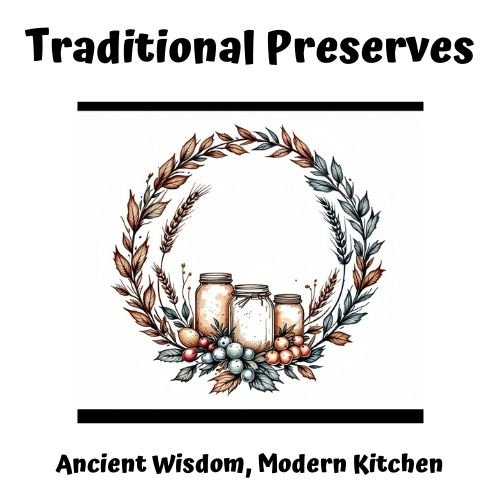
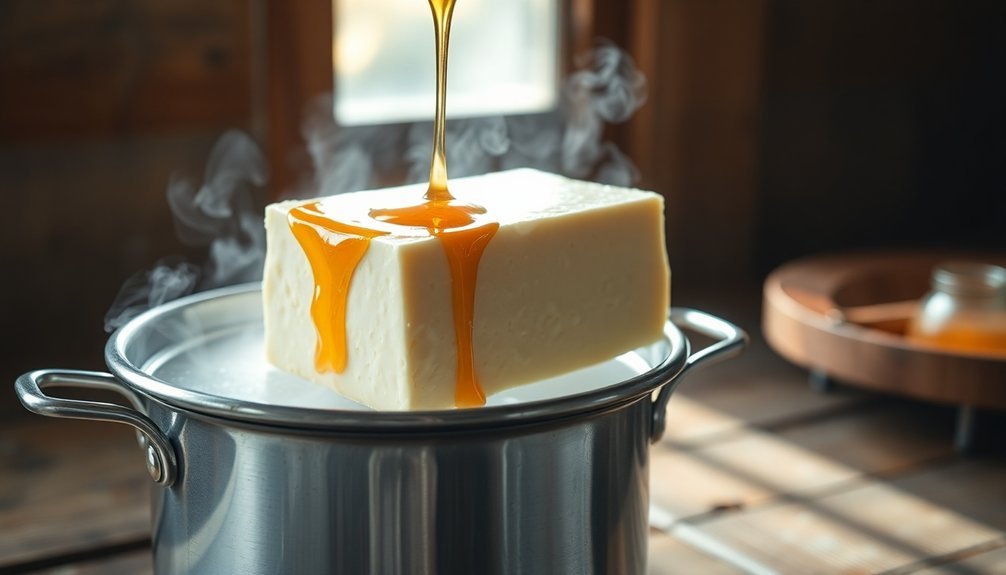
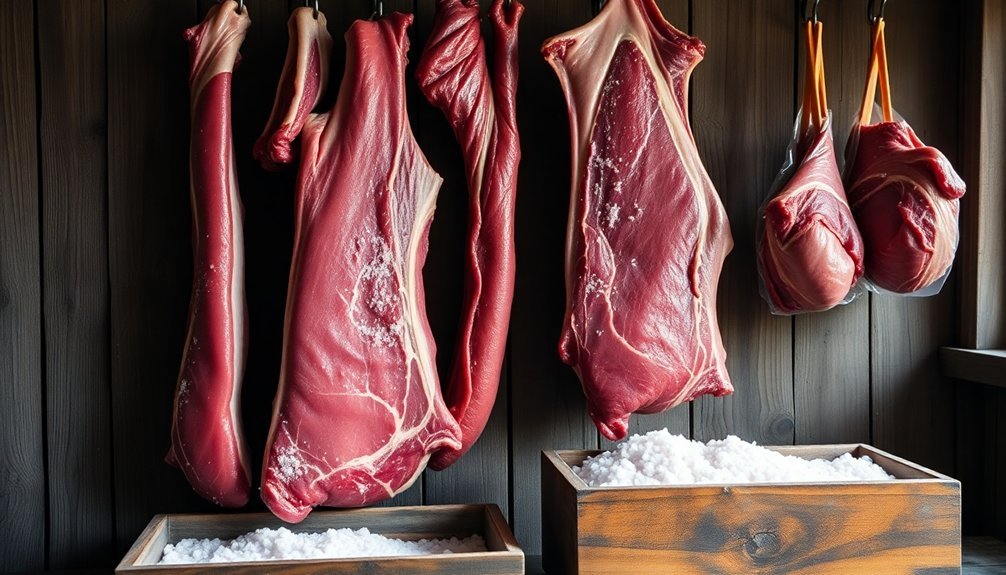
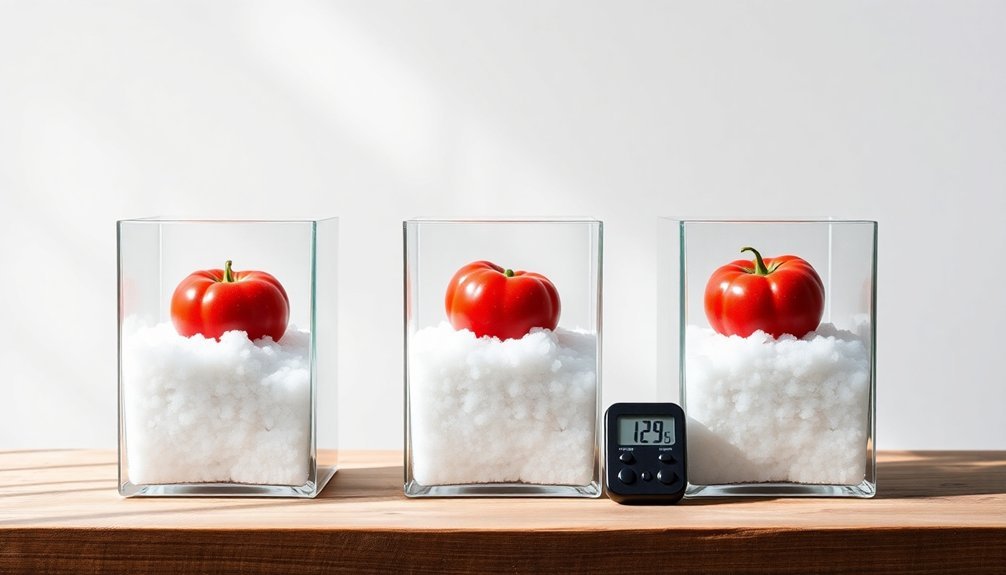
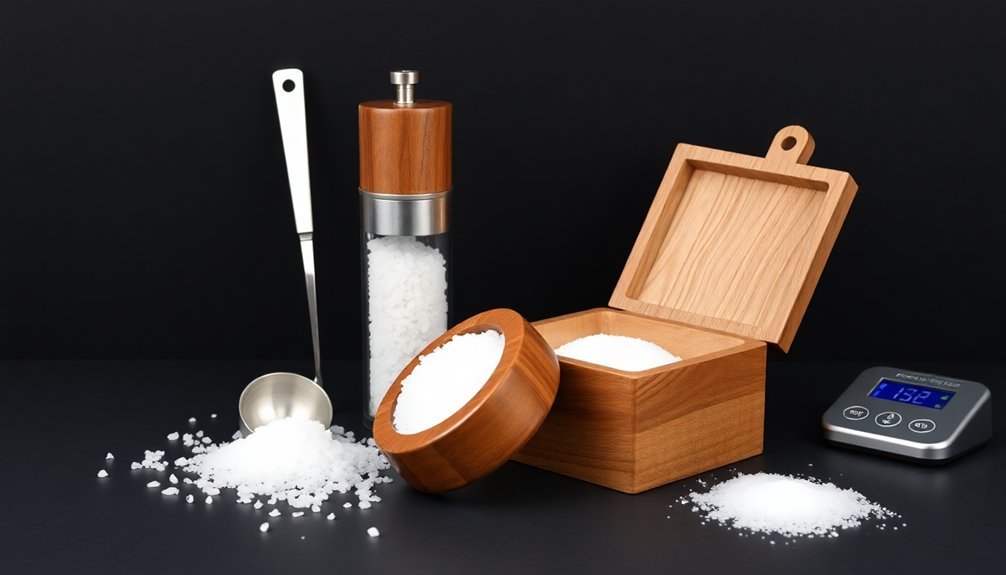
Leave a Reply